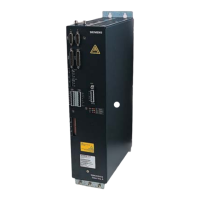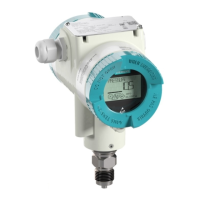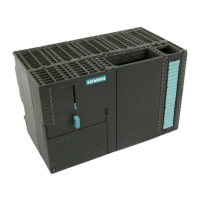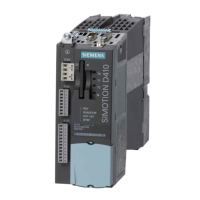6
6.2 Positioning mode (P0700 = 3, from SW 2.1)
6-417
Siemens AG 2005 All Rights Reserved
SIMODRIVE 611 universal Description of Functions (FBU) – 04.05 Edition
Table 6-38 Parameters used to program traversing blocks, continued
No. EffectiveUnitsMax.StandardMin.Name
ABSOLUTE or RELATIVE for rotary axis with modulo correction (from SW 2.4)
– ABSOLUTE:
The axis approaches the program position within the modulo range, and it automati-
cally selects the shortest distance. For the same distance in both directions, the axis
moves in the positive direction.
For values with a negative sign or a value outside the modulo range, an appropriate
fault is output when a traversing block starts.
– RELATIVE:
The axis traverses through the programmed position in a negative or positive direction
and refers itself to the position which was last approached.
The traversing distance can also be greater than the modulo range.
0087:64
xxXx
Positioning mode ABS_POS or ABS_NEG (only rotary axis with modulo correction)
With this information, for a rotary axis with modulo correction (P0241 = 1), the direction of
travel is specified along with the reference position.
– ABS_POS (from SW 2.4):
The rotary axis traverses in the positive direction with respect to the reference position
within the modulo range.
– ABS_NEG (from SW 2.4):
The rotary axis traverses in the negative direction with respect to the reference position
within the modulo range.
Note:
An appropriate fault is signaled when starting a traversing block for values with negative sign
or for a value outside the modulo range.
–
+
Example:
Positioning mode = ABS_POS
Position = 315
––> traverse to 315° in a pos. direction
Example:
Positioning mode = ABS_NEG
Position = 315
––> traverse to 315° in a neg. direction
ABS_POS ABS_NEG
Reference position
45°
90°
135°
180°
225°
270°
315°
0°
Actual position
Actual positionReference position
45°
90°
135°
180°
225°
270°
315°
0°
0087:64
xXxx
Block change enable END
The block change enable can be used for the following traversing blocks:
For pure single block operation, i.e. each block must be individually selected and started
At the last block of a block sequence, i.e. the block identifies the end of the block se-
quence.
6 Description of the Functions
04.99

